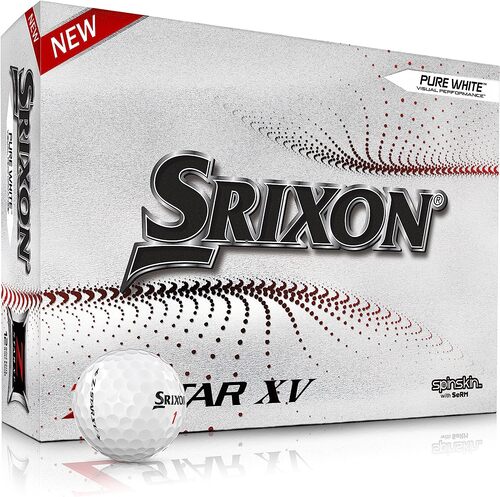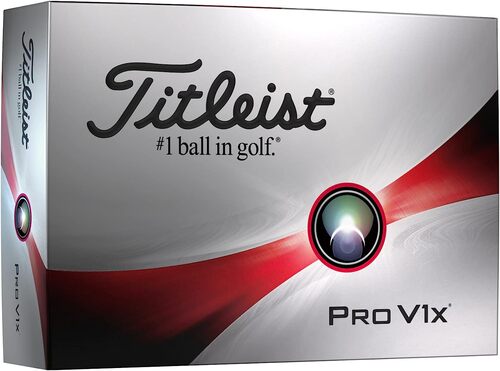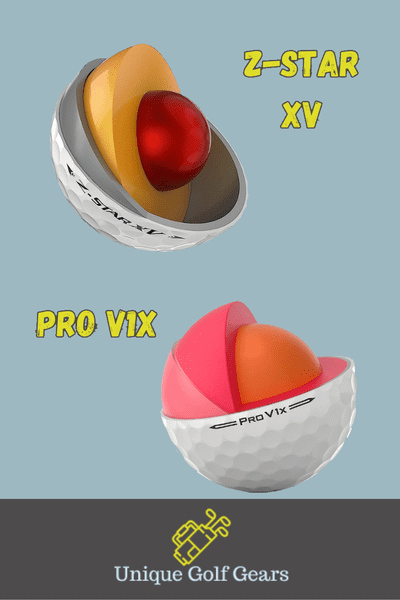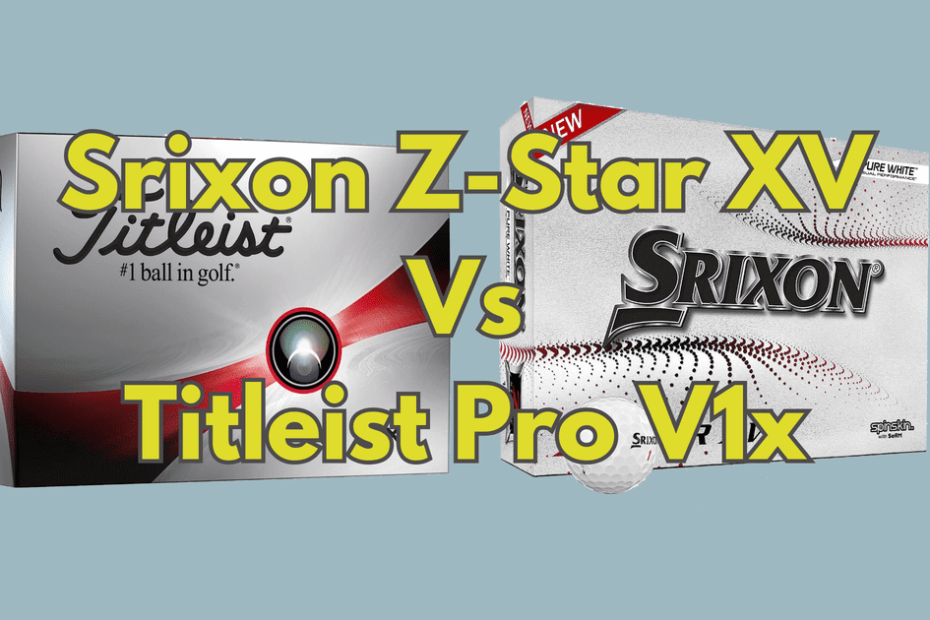Srixon Z Star XV Vs Titleist Pro V1x golf balls. Which Is Best! Let’s look at distance, spin, and control to find out how they perform.
The Titleist Pro V1 and Pro V1x are still the most popular golf balls in the world. They have been the top choice for professional tours and amateur players worldwide for years. In fact, Titleist accounts for more than 70% of the balls in play on the PGA Tour.
Srixon is among the manufacturers vying for market dominance, offering a range of golf balls spanning all market segments. These range from the premium options like the Z-Star down to more budget options such as the soft feel.
In today’s article we will be comparing the Titleist Pro V1x and the Srixon Z-Star XV to find out once and for all which is the better premium golf ball.
Brief Overview
Srixon’s XV serves as their counterpart to the Pro V1x, providing comparable performance to Titleist’s offering but at a slightly more affordable price point.
We highly suggest that you invest some time in hitting balls using a launch monitor to determine which ball aligns better with your swing. Additionally, you’ll play far more shots on the green than off the tee. This makes it crucial to take into account the ball’s feel on and around the green.

The Z-Star XV Golf Balls are an excellent, high-performance, tour quality offering from Srixon. They are manufactured with a robust 4-piece construction and some top of the line features.
Designed for high-speed players, the FastLayer Core starts soft in the center and gradually becomes firm around the edges, delivering exceptional feel and explosive ball speed for unmatched distance.
They have also developed a new Spin Skin with SeRM. This cutting-edge, thermoplastic urethane cover is fortified with a durable coating, featuring flexible molecular bonds. This gives you exceptional control and stopping power as it seamlessly grips wedge and iron grooves, generating maximum spin for pinpoint accuracy.
To top it off, they’ve incorporated a 338 Speed Dimple Pattern. This drastically reduces drag and increases lift. Not only does this give them great distance but they are also affected far less by strong winds.

Titleist Pro V1x golf balls are the pro tour standard, engineered for maximum spin and control. They offer enhanced tee shots that travel longer and straighter thanks to their high-speed, high-spin design. The Pro V1x golf balls from Titleist are built with a multi-component construction, featuring a high-energy ZG process core and a urethane elastomer cover. These combined features deliver exceptional distance, control, and durability. Whether you aim to elevate your game or compete at a professional level, choosing Titleist Pro V1x golf balls is an excellent decision for golfers who prioritize both distance and control.
Srixon Z Star XV Vs Titleist Pro V1x
Construction

The above image shows the construction of both the Z Star XV and the Pro V1x balls. As you can see, they are both made with a 4-piece design. Made from similar materials, there is nothing to separate them here.
Compression
According to the respective manufacturers, the Srixon balls have a compression of 102 whilst the Titleist balls have a compression of 97. These would both be considered high compression golf balls. Although, again, there is not much to choose between them.
Driving
Driver distance from the tee is an important factor to consider when choosing a golf ball. Every extra yard you gain here will help you pick up shots throughout the round. Easier approach shots and shorter putts are just some of the advantages you can gain with good distance off the tee.
We tested both these balls using the Callaway X Hot driver playing a full round with each ball. Here we did notice a couple of differences.
However, we should start off by saying that we couldn’t split them on distance. Perhaps the Pro V1x’s had a little more to give but we’re talking inches, not yards.
The biggest difference came from the ball flight. When using shot shaping, we found that the Z-Star XV’s had more movement to them. This could be seen as a good thing or a bad thing. If you have a heavy natural draw or fade, then the Pro V1x may be a better choice to keep you on the fairway.
On the other hand, if you frequently employ fades and draws in your game to create nicer angles, the Z-Star XV’s will make this considerably easier. It comes down to your style of play.
Feel
Feel is one of those things that is so subjective and kind of hard to describe! But being higher compression balls, they will generally feel firmer to most people. This is especially true if you have a relatively slow swing speed, say sub 100mph.
If you have a fast swing speed, 100mph+, they will almost have a bit of a bounce upon contact. That’s no surprise really. They’re not the rocks you hammer at the driving range to blow off steam, they are tour balls after all.
As far as differences are concerned, there really aren’t any that we noticed. Both have a clean feel off the tee and a firm feel around the green. Perhaps a better player than us could tell them apart but we struggled.
Spin
Once again, there is not much difference that we could detect between the 2 balls. Although we did note a few minor observations.
We mentioned above the shot shaping differences and we believe this comes down to spin. The Srixon Z-Star XV had a higher rpm from the tee. Not by much but it was definitely there.
On our approach shots we were highly impressed with both balls. Using a variety of wedges and irons we were able to generate immense backspin. Which did land us in trouble a few times with some dodgy lies, but that was most certainly human error.
The Z-Star XV and the Pro V1x both stopped on a dime. This is the area of the course that these premium tour balls are simply a cut above the rest. We were skeptical that the XV could stick with the Pro V1x here but it more than held its own.
Provided you have a good consistent swing either ball would yield reliable results from these ranges.
Putting
It is no coincidence that soft insert putters came to prominence around the same time solid core balls started replacing balata balls on tour.
When choosing a ball, it is important to consider how the ball feels around the green as this is where we take most of our shots from.
Both the Z Star XV and the Pro V1x are excellent for putting. They both feel firm and a little heavy, which we like. This means you get a nice solid contact and a good clean roll. We found no discernible difference between the two.
We should say that we got better results using an insert putter rather than a milled putter. But then that could just be because of our skill level, or lack thereof!
However, this comes down to personal preference. You might be more comfortable with a softer ball for putting.
Dispersion
These balls demonstrated remarkable performance in terms of dispersion from front to back, especially when using wedges. Both the Z-Star XV and the Pro V1x showcased consistent and predictable shot lengths, with the Pro V1x possibly holding a slight advantage. Having a clear understanding of the specific distances your irons, especially wedges, can achieve is a valuable asset. If you possess a steady and consistent game, this aspect could be the determining factor that sets these balls apart for you.
Color Options
The Srixon Z-Star XV are available in 3 different color options. These are:
White
Tour Yellow
Divide (Half white and half yellow)
The Titleist Pro V1x are available in 2 different color options. These are:
White
Tour Yellow


Srixon Z-Star XV: Final Thoughts
The Srixon Z-Star XV is an excellent option for various player profiles, especially those with higher swing speeds who favor a firmer ball. However, if you already have a relatively wide dispersion, transitioning to a tour ball may be more of a hinderance than a help. They tend to generate more spin which may lead to shots going further offline.
Should You Use Srixon Z Star XV?
If you are already using a premium ball, it is certainly worth considering testing the Z-Star XV. If you prefer a firmer feel and have a higher swing speed, it could be a suitable option for you.
Should You Use Previous Generations Of Z-Star XV?
It is important to note that the difference between generations of balls from manufacturers is often very minimal.
If you stumble upon older generations of the Z-Star XV at a reasonable price, don’t hesitate to grab them. You are unlikely to notice any significant differences unless you are an elite golfer or a professional tour player.
Titleist Pro V1x: Final Thoughts
This ball is widely renowned and highly favored among many professional tour players. Although it is also true that some of these players are contractually obligated through sponsorship deals and the like. Titleist remains the preferred choice among many players who are not tied to a manufacturer through such sponsorships.
You can’t go wrong with this high quality tour ball.
Should You Use Titleist Pro V1x?
Titleist Pro V1x is a great ball for those who prefer a firmer feel. Although, if you lose a few balls every round, this could soon add up!
Srixon Z-Star XV vs Titleist Pro V1x: Conclusion
Both balls are suitable for players with faster swings. If you’re looking to save some money, I recommend choosing the Srixon option.
When it comes to performance, there is not a significant difference between the two. However, if you often lose multiple balls during a round, opting for the Z-Star XV might be more budget-friendly for you!
Other Srixon Balls To Consider
You may also want to consider exploring the Q Star or Q Star Tour options. The Q Star is a 2-piece ball, while the Q Star Tour is a 3-piece ball with a urethane cover, available at a significantly lower retail price compared to the Pro V1.
FAQs
What is the Srixon equivalent of the Pro V1x?
The Srixon Z-Star XV is the equivalent of the Titleist Pro V1x. It is a tour-level golf ball from Srixon, featuring a 4-piece construction with a urethane cover. With a comparable compression rate to the Pro V1x, the Z-Star XV delivers excellent distance with a driver and high wedge spin.
Is The Pro V1x suitable for high handicappers?
Titleist Pro V1x balls are tour quality and suitable for use by all players. However, a high handicapper that loses a few balls per round may want something cheaper, but still premium quality, such as the Srixon Z Star XV.
Which Pros Use Srixon Z-Star XV?
Hideki Matsuyama, Shane Lowry, Keegan Bradley, Graeme McDowell, Martin Laird, Cameron Champ, JB Holmes, and Ernie Els all use the Z-Star XV.
What is the difference between Srixon Z Star and Z Star XV?
The XV boasts a higher compression rating thanks to its 4-piece construction. Rather than the 3-piece construction of the standard Z Star. As a result, the Z-Star is expected to generate more spin around the green, while the XV is designed to achieve a slightly higher trajectory during flight.
Srixon Z Star XV vs Pro V1x?
There is little discernible distinction between these two balls. In fact, it is doubtful that one would be able to perceive any difference. Unless you are a professional, you would need a launch monitor to tell them apart.
Which Srixon Ball Is Like The Pro V1?
The Z-Star is Srixon’s equivalent ball to the Titleist Pro V1. It provides a comparable level of performance in terms of spin, trajectory, and distance.
Which Srixon Ball Is Like The Pro V1x?
The Z-Star XV is Srixon’s equivalent ball to the Titleist Pro V1x. It provides a comparable level of performance in terms of spin, trajectory, and distance.






